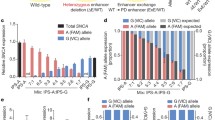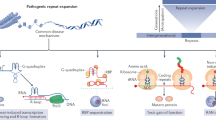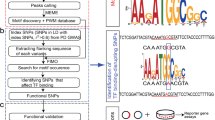Abstract
Short structural variants—variants other than single nucleotide polymorphisms—are hypothesized to contribute to many complex diseases, possibly by modulating gene expression. However, the molecular mechanisms by which noncoding short structural variants exert their effects on gene regulation have not been discovered. Here, we study simple sequence repeats (SSRs), a common class of short structural variants. Previously, we showed that repetitive sequences can directly influence the binding of transcription factors to their proximate recognition sites, a mechanism we termed non-consensus binding. In this study, we focus on the SSR termed Rep1, which was associated with Parkinson’s disease (PD) and has been implicated in the cis-regulation of the PD-risk SNCA gene. We show that Rep1 acts via the non-consensus binding mechanism to affect the binding of transcription factors from the GATA and ELK families to their specific sites located right next to the Rep1 repeat. Next, we performed an expression analysis to further our understanding regarding the GATA and ELK family members that are potentially relevant for SNCA transcriptional regulation in health and disease. Our analysis indicates a potential role for GATA2, consistent with previous reports. Our study proposes non-consensus transcription factor binding as a potential mechanism through which noncoding repeat variants could exert their pathogenic effects by regulating gene expression.




Similar content being viewed by others
References
Mirkin SM (2007) Expandable DNA repeats and human disease. Nature 447:932–940
Pearson CE, Nichol Edamura K, Cleary JD (2005) Repeat instability: mechanisms of dynamic mutations. Nat Rev Genet 6:729–742
Willems T, Gymrek M, Highnam G, Genomes Project C, Mittelman D, Erlich Y (2014) The landscape of human STR variation. Genome Res 24:1894–1904
Gymrek M, Willems T, Guilmatre A, Zeng H, Markus B, Georgiev S et al (2016) Abundant contribution of short tandem repeats to gene expression variation in humans. Nat Genet 48:22–29
Akai J, Kimura A, Hata RI (1999) Transcriptional regulation of the human type I collagen alpha2 (COL1A2) gene by the combination of two dinucleotide repeats. Gene 239:65–73
Chiba-Falek O, Nussbaum RL (2001) Effect of allelic variation at the NACP-Rep1 repeat upstream of the alpha-synuclein gene (SNCA) on transcription in a cell culture luciferase reporter system. Hum Mol Genet 10:3101–3109
Okladnova O, Syagailo YV, Tranitz M, Stober G, Riederer P, Mossner R et al (1998) A promoter-associated polymorphic repeat modulates PAX-6 expression in human brain. Biochem Biophys Res Commun 248:402–405
Peters DG, Kassam A, St Jean PL, Yonas H, Ferrell RE (1999) Functional polymorphism in the matrix metalloproteinase-9 promoter as a potential risk factor for intracranial aneurysm. Stroke 30:2612–2616
Searle S, Blackwell JM (1999) Evidence for a functional repeat polymorphism in the promoter of the human NRAMP1 gene that correlates with autoimmune versus infectious disease susceptibility. J Med Genet 36:295–299
Shimajiri S, Arima N, Tanimoto A, Murata Y, Hamada T, Wang KY et al (1999) Shortened microsatellite d(CA)21 sequence down-regulates promoter activity of matrix metalloproteinase 9 gene. FEBS Lett 455:70–74
Hefferon TW, Groman JD, Yurk CE, Cutting GR (2004) A variable dinucleotide repeat in the CFTR gene contributes to phenotype diversity by forming RNA secondary structures that alter splicing. Proc Natl Acad Sci U S A 101:3504–3509
Maraganore DM, de Andrade M, Elbaz A, Farrer MJ, Ioannidis JP, Kruger R et al (2006) Collaborative analysis of alpha-synuclein gene promoter variability and Parkinson disease. JAMA 296:661–670
Xia Y, Rohan de Silva HA, Rosi BL, Yamaoka LH, Rimmler JB, Pericak-Vance MA et al (1996) Genetic studies in Alzheimer’s disease with an NACP/alpha-synuclein polymorphism. Ann Neurol 40:207–215
Touchman JW, Dehejia A, Chiba-Falek O, Cabin DE, Schwartz JR, Orrison BM et al (2001) Human and mouse alpha-synuclein genes: comparative genomic sequence analysis and identification of a novel gene regulatory element. Genome Res 11:78–86
Goldman SM, Umbach DM, Kamel F, Tanner CM (2015) Head injury, alpha-synuclein Rep1 and Parkinson’s disease: a meta-analytic view of gene-environment interaction. Eur J Neurol 22:e75
Kay DM, Factor SA, Samii A, Higgins DS, Griffith A, Roberts JW et al (2008) Genetic association between alpha-synuclein and idiopathic Parkinson’s disease. Am J Med Genet B Neuropsychiatr Genet 147B:1222–1230
Farrer M, Maraganore DM, Lockhart P, Singleton A, Lesnick TG, de Andrade M et al (2001) alpha-Synuclein gene haplotypes are associated with Parkinson’s disease. Hum Mol Genet 10:1847–1851
Mizuta I, Nishimura M, Mizuta E, Yamasaki S, Ohta M, Kuno S (2002) Meta-analysis of alpha synuclein/ NACP polymorphism in Parkinson’s disease in Japan. J Neurol Neurosurg Psychiatry 73:350
Mellick GD, Maraganore DM, Silburn PA (2005) Australian data and meta-analysis lend support for alpha-synuclein (NACP-Rep1) as a risk factor for Parkinson’s disease. Neurosci Lett 375:112–116
Linnertz C, Saucier L, Ge D, Cronin KD, Burke JR, Browndyke JN et al (2009) Genetic regulation of alpha-synuclein mRNA expression in various human brain tissues. PLoS One 4:e7480
Chiba-Falek O, Touchman JW, Nussbaum RL (2003) Functional analysis of intra-allelic variation at NACP-Rep1 in the alpha-synuclein gene. Hum Genet 113:426–431
Cronin KD, Ge D, Manninger P, Linnertz C, Rossoshek A, Orrison BM et al (2009) Expansion of the Parkinson disease-associated SNCA-Rep1 allele upregulates human alpha-synuclein in transgenic mouse brain. Hum Mol Genet 18:3274–3285
Saul R, Lutz MW, Burns DK, Roses AD, Chiba-Falek O (2016) The SSV evaluation system: a tool to prioritize short structural variants for studies of possible regulatory and causal variants. Hum Mutat 37:877–883
Afek A, Cohen H, Barber-Zucker S, Gordan R, Lukatsky DB (2015) Nonconsensus protein binding to repetitive DNA sequence elements significantly affects eukaryotic genomes. PLoS Comput Biol 11:e1004429
Afek A, Schipper JL, Horton J, Gordan R, Lukatsky DB (2014) Protein-DNA binding in the absence of specific base-pair recognition. Proc Natl Acad Sci U S A 111:17140–17145
Berger MF, Philippakis AA, Qureshi AM, He FS, Estep PW 3rd, Bulyk ML (2006) Compact, universal DNA microarrays to comprehensively determine transcription-factor binding site specificities. Nat Biotechnol 24:1429–1435
Hume MA, Barrera LA, Gisselbrecht SS, Bulyk ML (2015) UniPROBE, update 2015: new tools and content for the online database of protein-binding microarray data on protein-DNA interactions. Nucleic Acids Res 43:D117–D122
Weirauch MT, Yang A, Albu M, Cote AG, Montenegro-Montero A, Drewe P et al (2014) Determination and inference of eukaryotic transcription factor sequence specificity. Cell 158:1431–1443
Wei GH, Badis G, Berger MF, Kivioja T, Palin K, Enge M et al (2010) Genome-wide analysis of ETS-family DNA-binding in vitro and in vivo. EMBO J 29:2147–2160
Nardelli J, Thiesson D, Fujiwara Y, Tsai FY, Orkin SH (1999) Expression and genetic interaction of transcription factors GATA-2 and GATA-3 during development of the mouse central nervous system. Dev Biol 210:305–321
Scherzer CR, Grass JA, Liao Z, Pepivani I, Zheng B, Eklund AC et al (2008) GATA transcription factors directly regulate the Parkinson’s disease-linked gene alpha-synuclein. Proc Natl Acad Sci U S A 105:10907–10912
Brenner S, Wersinger C, Gasser T (2015) Transcriptional regulation of the alpha-synuclein gene in human brain tissue. Neurosci Lett 599:140–145
Berger MF, Bulyk ML (2009) Universal protein-binding microarrays for the comprehensive characterization of the DNA-binding specificities of transcription factors. Nat Protoc 4:393–411
Barrera LA, Vedenko A, Kurland JV, Rogers JM, Gisselbrecht SS, Rossin EJ et al (2016) Survey of variation in human transcription factors reveals prevalent DNA binding changes. Science 351:1450–1454
Gordan R, Hartemink AJ, Bulyk ML (2009) Distinguishing direct versus indirect transcription factor-DNA interactions. Genome Res 19:2090–2100
Chiba-Falek O, Lopez GJ, Nussbaum RL (2006) Levels of alpha-synuclein mRNA in sporadic Parkinson disease patients. Mov Disord 21:1703–1708
Linnertz C, Anderson L, Gottschalk W, Crenshaw D, Lutz MW, Allen J et al (2014) The cis-regulatory effect of an Alzheimer’s disease-associated poly-T locus on expression of TOMM40 and apolipoprotein E genes. Alzheimer's Dementia : J Alzheimer's Assoc 10:541–551
Linnertz C, Lutz MW, Ervin JF, Allen J, Miller NR, Welsh-Bohmer KA et al (2014) The genetic contributions of SNCA and LRRK2 genes to Lewy body pathology in Alzheimer’s disease. Hum Mol Genet 23:4814–4821
Singleton AB, Farrer M, Johnson J, Singleton A, Hague S, Kachergus J et al (2003) alpha-Synuclein locus triplication causes Parkinson’s disease. Science 302:841
Farrer M, Kachergus J, Forno L, Lincoln S, Wang DS, Hulihan M et al (2004) Comparison of kindreds with parkinsonism and alpha-synuclein genomic multiplications. Ann Neurol 55:174–179
Miller DW, Hague SM, Clarimon J, Baptista M, Gwinn-Hardy K, Cookson MR et al (2004) Alpha-synuclein in blood and brain from familial Parkinson disease with SNCA locus triplication. Neurology 62:1835–1838
Grundemann J, Schlaudraff F, Haeckel O, Liss B (2008) Elevated alpha-synuclein mRNA levels in individual UV-laser-microdissected dopaminergic substantia nigra neurons in idiopathic Parkinson’s disease. Nucleic Acids Res 36:e38
Rockenstein E, Hansen LA, Mallory M, Trojanowski JQ, Galasko D, Masliah E (2001) Altered expression of the synuclein family mRNA in Lewy body and Alzheimer’s disease. Brain Res 914:48–56
Asi YT, Simpson JE, Heath PR, Wharton SB, Lees AJ, Revesz T et al (2014) Alpha-synuclein mRNA expression in oligodendrocytes in MSA. Glia 62:964–970
Lutz MW, Saul R, Linnertz C, Glenn OC, Roses AD, Chiba-Falek O (2015) A cytosine-thymine (CT)-rich haplotype in intron 4 of SNCA confers risk for Lewy body pathology in Alzheimer’s disease and affects SNCA expression. Alzheimer's Dementia : J Alzheimer's Assoc. 11:1133–1143
Soldner F, Stelzer Y, Shivalila CS, Abraham BJ, Latourelle JC, Barrasa MI et al (2016) Parkinson-associated risk variant in distal enhancer of alpha-synuclein modulates target gene expression. Nature 533:95–99
Tagliafierro L, Glenn OC, Zamora ME, Beach TG, Woltjer RL, Lutz MW et al (2017) Genetic analysis of alpha-synuclein 3′ untranslated region and its corresponding microRNAs in relation to Parkinson's compared to dementia with Lewy bodies. Alzheimers Dement
Bonhoure N, Bounova G, Bernasconi D, Praz V, Lammers F, Canella D et al (2014) Quantifying ChIP-seq data: a spiking method providing an internal reference for sample-to-sample normalization. Genome Res 24:1157–1168
Lutz MW, Saul R, Linnertz C, Glenn OC, Roses AD, Chiba-Falek O. A cytosine-thymine (CT)-rich haplotype in intron 4 of SNCA confers risk for Lewy body pathology in Alzheimer's disease and affects SNCA expression. Alzheimer's Dementia :J Alzheimer’s Assoc. 2015
Livak KJ, Schmittgen TD (2001) Analysis of relative gene expression data using real-time quantitative PCR and the 2(−delta delta C(T)) method. Methods (San Diego, Calif) 25:402–408
Gordan R, Shen N, Dror I, Zhou T, Horton J, Rohs R et al (2013) Genomic regions flanking E-box binding sites influence DNA binding specificity of bHLH transcription factors through DNA shape. Cell Rep 3:1093–1104
Mordelet F, Horton J, Hartemink AJ, Engelhardt BE, Gordan R (2013) Stability selection for regression-based models of transcription factor-DNA binding specificity. Bioinformatics 29:i117–i125
Acknowledgements
We thank the Layton Aging and Alzheimer’s Disease Center at Oregon Health and Science University for providing us with the brain tissues, and Dr. Randy Woltjer for his assistance in obtaining the required brain samples for the study.
Funding
This work was funded in part by the Holland-Trice award (to O.C-F. and R.G.), the National Institutes of Health/National Institute of Neurological Disorders and Stroke (NIH/NINDS) (R01 NS085011 to O.C-F.), and the National Institutes of Health/National Institute of General Medical Sciences (NIH/NIGMS) (R01 GM117106 to R.G.).
Author information
Authors and Affiliations
Corresponding authors
Ethics declarations
The projects were approved by the Duke Institutional Review Board and followed appropriate ethical protocols, and all experiments were performed in accordance with relevant guidelines and regulations.
Conflict of interest
The authors declare that they have no competing interests.
Electronic supplementary material
ESM 1
(PDF 513 kb)
Rights and permissions
About this article
Cite this article
Afek, A., Tagliafierro, L., Glenn, O. et al. Toward deciphering the mechanistic role of variations in the Rep1 repeat site in the transcription regulation of SNCA gene. Neurogenetics 19, 135–144 (2018). https://doi.org/10.1007/s10048-018-0546-8
Received:
Accepted:
Published:
Issue Date:
DOI: https://doi.org/10.1007/s10048-018-0546-8




